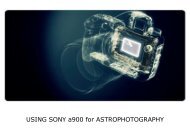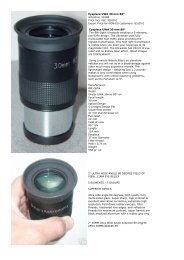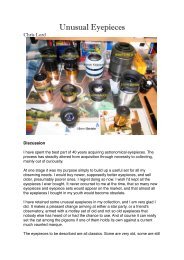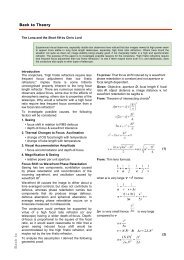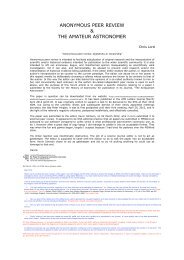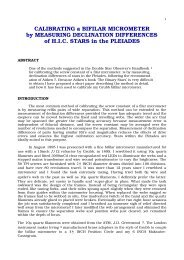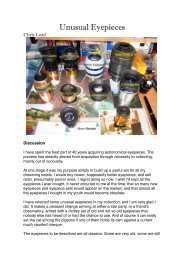Evolution of the Astronomical Eyepiece - Brayebrook Observatory
Evolution of the Astronomical Eyepiece - Brayebrook Observatory
Evolution of the Astronomical Eyepiece - Brayebrook Observatory
Create successful ePaper yourself
Turn your PDF publications into a flip-book with our unique Google optimized e-Paper software.
EVOLUTION <strong>of</strong> <strong>the</strong> ASTRONOMICAL EYEPIECE<br />
VARIANTS OF SOLID EYEPIECES:<br />
No single element eyepiece, no matter<br />
what <strong>the</strong> form or figure on its surface<br />
can be corrected for both spherical and<br />
c h romatic a berration. Following <strong>the</strong><br />
manufacture <strong>of</strong> Chester Moor Hall’s<br />
prototype achromatic doublet by <strong>the</strong><br />
jobbing optician George Bass, and <strong>the</strong><br />
work <strong>of</strong> Leonhard Euler an d S.<br />
K l i n g e n s t i e rna on <strong>the</strong> geometrical<br />
method <strong>of</strong> simultaneously correcting<br />
both spherical and chromatic aberration<br />
in object-glasses, John Dollond<br />
assembled <strong>the</strong> first achromatic lens. It<br />
had plano-concave flint and equi-con -<br />
vex crown componen ts, with focal<br />
length in <strong>the</strong> ratio <strong>of</strong> <strong>the</strong>ir dispersive<br />
powers. Dollond manufactured doublets<br />
in small sizes from about 1759,<br />
and employed <strong>the</strong>m in microscopes<br />
and telescopes as objectives and as an<br />
inverting eyepiece.<br />
THE ACHROMATIC DOUBLET:<br />
Possesses a much wider f ield with<br />
superior edge definition to a simple<br />
Keplerian type, and was well suited to<br />
<strong>the</strong> shorter focal l en gth achro m a t i c<br />
refractors <strong>of</strong> <strong>the</strong> late C18th. It shares<br />
<strong>the</strong> same eye relief <strong>of</strong> about 0.9Fe.<br />
Lenses <strong>of</strong> this form were scarce and<br />
expensive to produce because <strong>of</strong> <strong>the</strong><br />
difficulty in pouring bubble and striae<br />
free flint glass. It was not until 1828<br />
when H. Guinand founded an opticalglass<br />
works at Choisy-le-Roi, on <strong>the</strong><br />
principles <strong>of</strong> <strong>the</strong> research carried out<br />
by his fa<strong>the</strong>r, Pierre Louis Guinand, a<br />
Swiss horologist <strong>of</strong> Les Brenets, for<br />
Joseph Fraunh<strong>of</strong>er, that this technological<br />
deficiency was rectified. During<br />
<strong>the</strong> French revolution <strong>of</strong> 1848, George<br />
Bontemps, an employee <strong>of</strong> Guinand,<br />
left for England bringing with him a<br />
number <strong>of</strong> French and Belgium sheetgla<br />
ssma kers. Bon tem ps joi ned <strong>the</strong><br />
newly f oun ded Birmi ngham f irm ,<br />
Chance Bro<strong>the</strong>rs, and imparted his<br />
techni ca l knowledge. Within a few<br />
years, English optical-glass production<br />
surpassed tha t established on <strong>the</strong><br />
Continent.<br />
It was only with <strong>the</strong> development <strong>of</strong><br />
optica l-gla ss production techno logy,<br />
and <strong>the</strong> availability <strong>of</strong> a variety <strong>of</strong><br />
cr own and flint glasses having differing<br />
refracting and dispersive powers. that<br />
i t be came feasib le to de sign a nd<br />
m a n u f a c t u r e ach ro mat ic lenses in<br />
a ny qua nti ty.<br />
20





